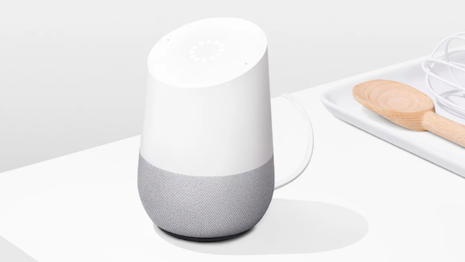As consumers increasingly use virtual voice assistants such as the Amazon Echo or Google Home for shopping, a new report indicates brand visibility and loyalty are at risk.
A survey from Digitas found that 85 percent of consumers have purchased the first product result offered by one of these devices, which in many cases is not from the brand they originally searched for. Millennials, who will make up half of the luxury market in a matter of years, show an even greater tendency towards settling for a device's pick.
"Because voice devices highlight a preferred brand, it can be challenging to maneuver your brand into the lead position," said Jenna Sheeran, senior vice president of search marketing at Digitas, Boston. "Providing consumers with the right content—and equipping them with the right search terms—will increase your chances of being served first by the algorithm."
Digitas' report is based on a survey of 2,019 U.S. adults conducted by The Harris Poll.
First choice
While still an emerging retail technology, virtual voice assistants are increasingly being used for commerce.
A report from Episerver found that around 40 percent of consumers own voice-activated artificial intelligence assistants. About 60 percent of them do not currently use them to search for products and fewer actually purchase anything (see story).
However, by 2022, it is projected that 55 percent of households will have a VVA, and the ecommerce market around these devices will reach $40 billion.

Google's software dominance has led to its success in the hardware sector as well. Image credit: Google
Millennials are more apt to show interest in purchasing products via a VVA than older generations. This is particularly true for categories including beauty, clothing, accessories and technology.
For instance, while only 25 percent of those over the age of 45 would be open to buying beauty products through a VVA, 56 percent of millennials show an openness to buying via one of these devices.
When shoppers prompt a VVA with a search term, the algorithms used by the AI assistant are programmed to return a “preferred option.” Often this is not from the brand that the consumer originally asked for.
Only 24 percent of shoppers will ask a VVA for more options if the preferred option is not the brand they were seeking. Eighty-five percent of consumers say they have just bought the first VVA suggested product at least once.
While millennials are more likely to make a purchase on a VVA, they also have a greater tendency towards picking the first VVA option. Thirty-seven percent of millennial VVA buyers always or often go with the preferred option, compared to just 16 percent of those ages 45 and up.
When the VVA returns a listing that is not what the consumer asked for, 11 percent will abandon the purchase entirely. Some will instead go to a mobile application, Web site or store to buy instead.
Consumers show more of a tendency to expand their search when interacting with a screen-enabled VVA. With devices such as the Echo Show, 78 percent of consumers would scroll through more results if their first choice was not originally presented to them.

Consumers will often just buy the first result that a VVA suggests. Image credit: Amazon
To counteract the potential lost brand visibility on VVAs, Digitas suggests leveraging SEO. By figuring out the right search term to bring their product to the top, brands can suggest wording that customers can use when they are looking to buy from them.
Marketers can also seek out partnerships with device makers such as Amazon or Google. For luxury labels that typically eschew selling on Amazon, brands risk losing a sale or making the customer journey more complicated.
"Partnerships with leading voice platforms like Amazon and Google are crucial for a brand’s success in connecting with consumers," Ms. Sheeran said. "Brands need to take advantage of volume on partners’ devices to connect with active audiences.
"If brands are creating internal assistants — for instance bots on their Web site — they need to connect these efforts to engage with platforms like Alexa and Google Home to maximize reach," she said. "For example, events like Amazon Hack-a-thons can help drive innovation on voice platforms and offer unique branding opportunities to increase your brand’s value in voice."
Voice visibility
Today, 55 percent of all consumer product searches originate on Amazon. A lack of visibility on the ecommerce giant is therefore a detriment to gaining and retaining customers (see story).
Beyond commerce, brands should be thinking of the ways in which VVAs can fit into their consumer engagement.
The NPD Group notes that voice-activated speaker sales are climbing, with the researcher predicting that sales of these devices will grow by 50 percent by 2019.
With the growth of digital assistants such as Amazon's Alexa and Google Home expected to reach more than 1.8 billion consumers by 2021, the luxury landscape is open for a multitude of capabilities by integrating with this technology, illustrated in a report from iProspect and Bing.
High-end automakers as well as numerous other luxury brands have been continuing to integrate with digital assistants as the experience exudes opulence, catering to affluent consumers. According to Digital Assistants: Reordering Consumer Lives & Redefining Digital Marketing, currently more than 500 million individuals use some version of a digital assistant, which makes it imperative for luxury brands to stay ahead of the curve now that it has become universal for consumers across the board, and not just the affluent (see story).
"Luxury brands need to focus on building strong partnerships with Amazon to create brand activations or skills for their consumers," Ms. Sheeran said. "This will allow brands to interact with consumers on VVAs when their brand is requested, even if consumers can’t purchase these products directly on Amazon.
"If the brand does not create an experience in these environments, then they are losing out on valuable moments to engage with consumers," she said. "Brands should focus on what the consumer needs and how they can help them solve a challenge or stay on top of relevant trends."
{"ct":"j72MF3t6Aqbf18gtb0yxCoSSnuvQuw0+Sge0iBhhs8DEs2Hcl3vxBExkqAm2uU23hzI66jw7R4H1e4NDtC+7rZFr5jaN\/XEnaI\/IMpvlZP7afoWkoDZLUngtc+dysOqR5ogBt6jj91axTRUSldjx4I9yusg2ZNTJfMWRYI1j1T5W7l0AToKJis9GkkpIo7OqwdCtJuII\/iLORFEcVDZ1vXvPqZMzMujbVgU972tvWdFodKb2B\/BIxdbAHfCPrKxwbk0sa6bk8rKVueoVR5eRQ7w1TKOaWDY+nt8zDMqinFm\/7opN4zD4r8ZMvd4huqgels0FeIbGXXAhSq\/G01x4lFGvzvu+KP7fvmg\/AyROLnLdkXWEawfmJGQYxjdFVKl6zg+tXhKj4mms+E2aPvaSKOHiAhCLAyFk8NiSLfQwMBqnJZaOfMUpQaFcjUHkKRjxTV\/3OEZGFbmJxdHJ8itFY7msHRetGQL0E4WNQpG6i32wH1EUPqF39FqDaUo2AJr0LftqkC6kMIVRJtE9smTUou0Sfa\/8zO+kqE\/sf1r9ur8Ew2qDl8Yw8HQp909q7SYMPidKBtlC8gLn6kjhtdRuBe\/gjdzR7fTodWX0F1ippSd9y7NTti8O8ajc6\/vbPobf2evgc0CIYFifrMhUSOnOfdHRQL58H24bVFCLxD4zwnyZB3hHLD7Lzw\/zD06HPlVqngWvJGWZzNuk4cWtr1H7XMILGBlwpCq8gLEio6Sw2YZTJshnOBcDLhuAtGUxBlJW7po24Ev9Y+IND0Z05IJ1VmUs92znQAk2sYom5wOSslaT7Pzog+gJ0d4LGKxiU\/Kj9U8XsiY+6XKaT+YMIOXa3JmznhYx3ZS0PA4QLn0eZz4GkOfqoAtB3nPWA9GyEJaNx5R06v3x8b4pF\/SA1YN6IaDpv9F5Vs9jULNuKRfFwNQgVSj2LK\/tBS9u9J0QcmtqhGSBCQAEEqXx2NQNTgDZ0uPOzgnmsNLGq1c6D3Eus9YK989KRi+XN1kupqjcs4NCWKECtw2kteUc+tsQOsbYgeT+vzEMmlu9yvYUF1L0ba+luLgdlcY1BKKeS\/3\/rQ4BZUitjccCXGqYFAxkU8sGxZbfrJRSWUkV8e9MEzJeg18icrx8jIWtIkjOQuVwRxQjGorU1Nv6UGv0e1bRTEZSG3mTKkLUjQcp\/q2o\/XJpikEyh6SWvav4UxwOgbO4ianCg5QR0HJ7gMRHSdDbnraQc9MxxLRV8ztpcCT399gHLOvEoT1iPiK9HENxMiN6NVXiZIN4bOr5TmEWUtepDDP\/fvg5wefr48UswoqYeTg0fidd5yExvfnQ8cbbCnrBlCfd3SY9s9cbqc3DmzIex7zDjswoYNDMX\/o6QccGOuRN5fNB\/1\/9kR4mH7bdlJwBXycYzziT\/fqloOqWKPqQpZPk8IjGzVp\/T1L+zy7m8xtfzQHKPs8WJNipGKhSyqgswYf9tX9lqOCZPhfQZgGi3o5+XRWRSU4SidbuBpqwlnjnGbm0ynLK8lWouyz3DXVUzoneZBdG9wMF31WANfXUi+wC8qHaJVJw1NBhVqMMfsK+0vRhXDGbhyTfjCCv\/LTzDZ6PM44uGej\/EVnWRFm5iamSGSbNO939A3MMjSRH9fXhBTAPmwLVlewioPr1wyWilAd1sYcFAxR5kuXRB847ikt0W20FO1p6w5tz0eK8zIplL1ZAAAgeWgbuof+7gUSATD8Np5ruRUVVCphhzOBdb0QkPxnNiPB3otIOKIdBinZndQt2StCVSCPRQ1mRbbJKDZhrgKf7KUv8UjTciB9zBE5O6pobOvXShz4dq2\/1U5fpxD5mU+nCEEuKSZQ7r053TmR4nV5BCT4\/+szoJVdKWOY0adAQ0n\/k1ov1BMHU\/u5gY5x2PpCbZJFy+20geiYR+JnLy1aUzhMpGQEa4lXSp60r1iArlRWpzZzuF0jK04fu54r+UYqjHUMGDdenhjJ2uftSwV\/Lc2Yqi4vCytmMSMjrBCboGKcNkwMAfQfPDfSTU0wVELnoGRtDm9bCN5JPpLONf0vV4\/1GSw79ltmwWGifLhb82vnQk6CcnNEIgQQUkXDUeQpFoP5NBT3nuA1XP81J1lQvyKDd\/DVgbq35z\/tB\/7spjGygiAvB4m8EIbL2dtZc9c2v97Kboa9AfT3UPNoJoh6PcsB8ASxf9dg2OR4spZYHye\/7s5IzCBINXjNB6EZNcQ7zPm7lWjojFg8gHC0blqqVrClDECL\/Ch\/Jh1EqXwoY1z3asQBjY2hS4+nhIiQ8BIUQrgF95tLouBXKm\/exJiFLrqIM7Wn5Hcpect+E\/pqM6Cecrt56vXIsA7gKrMyuyPsX2FMgtlrPnfdUoScMGLL9\/vIEPGBfGb9mhcjNk561rEmNQN87S\/1H52U8+03p2xOfY+7M5gjCFRM6Oj85GaqFXTfgrRKR8HNm6GpRF\/xJv+Ha9MAYp2s+NSIrBAItdYcxyVSacbxSVTPnVlz+qXbpJI2F+SnDIQlO\/4Ntrbv9a6P5vEJIjLX\/E9rokCAqAEN7ubSlNdLiCOCps8oZkJAEfn2EFfcv5OqjypsRcslWk+WiqnH8i8xJe1cZxSjw8Spe4DTN\/7z+gQtWSa59QMzdl43CmBresRkqnkxxz13pPJq\/jiMqovGVqaN7vh8e\/yy0b21woKb\/gv\/RaiQOhihHq2V9JMI2VGz0Pcg06wKvpneEEDMoCK6gRPwFAxMO5qS\/DMfiGMgNlPL\/44gbonew7xGwZ8Zjy6\/WG7TysxYa7OWpmO9u2V+4xRAponQxsjNzM3EShY28VF59rfqDW3E4lyOZ0tbn5AAgmMasx6eVkEYxBQJZnBZ5iVt7tWC9783E0zrQ4tKPlao7auSIjRvEu+tSjLdpplFkBr4KI65183hoG8dYZWegMyjOrtcW4\/havXx02GbUsIHBzgtr+l95LGjVdEHRhcIWHUa\/YQfUSSP6sjV0htLHo38JG856qfY6x2MHwEEFblMYqQiG1o94Gi2edSN0TFgBulWk9ToaZRrUOoqURI\/vZOfgWgodCcyWNiQXDBN+umabizrx+zxAwvhVKjZfHd\/RjocIfGROpGmff4VTiV9v2IX4uMkREhnQ+YYQYDNy6qIcUPgGYtB6YIY7KX1VCk8oXAABt\/x6cOZlTgYyZVnIx7Sy5B0YNyKZ67ZRpBgVZtQYfWhkHva0pt5dgd6hRE7cd\/JdbNI2rGH7YfiVlq5E+X8uLyIiw37ST+bTjx8waNUBVSs1ozbkGSyOZpViJqQ60wLefX1\/+2nJrTWGn2s2FhCsC\/MnPFVrWNI0n8RLl9tvqOXTQ3EbqJFsgps3Wa7GEFGTyy6AfmLo3Me174hNUwjFEXQEbgaQWaRCbqFQv1LzmUAljr71uOnGdTHFYGQlJq2gKKdLhq5xpZ2ZVRGekGNHbDIlI7PmngTbI0Z\/EBqxFiPrn9qKD85BjX0ow8B3MMDoEMQgDEM5ht2M5PYc38DhV6gQ8xJ1JfzRPmP9zXrsg47mSanhr1EwY7OUpEHskuTChuFwIcXi38ENO2h9ygvXf5GhZsaHYp2xamodqGfe435b2cj6TJhuNxVfzweHQYhBb1lSQSJmBDjjI+ZFJDDU1U7Yy2Cn9iZZMBCBJZ6tsM7rlYkgXQQXKnx1+2RfyI\/GkdDfCtmWZaak5GpqbXb30twiOZKsrWDedUFwIXyhe0o1S5uyJCLdXh0T5DYyV42XXhHm39kRYzBRek8o6BXKegr3AAu0eczQ\/EqUOp0chfP3A\/qZgcx1hpoqD65+p00FeMXWfd+Oup6BHx4AgwjO2RwXLAEPzopqoO7GqbOflez6EK2tA+mshiwjeXEiOwoxUoF6glMKCPrUYQwwdhPDpqagO5ftsDPJCsW5Ckk8Ya4\/SKYYEPPAhVA+OQgh8l5qq5dmOq\/E1pREzGeFsJ71lhSzRR9qsiLn7MCfRvps0ojo1rDBLodrkXh\/qklBa8gAYuMm7mBTjk96Sx0dYhqT01W5MP7qjxvQh9ePhQhyIsgKwA6Tu7rsoqPnz1pmTGZZIBG5g4QHN+lMFAIzXIVSeDUlL5k3NvvMpgsVfldPl+wMDpu6lwYgGE2kqqjdEZY+fcNereyoFw9F5vLnI1Sb179G8MwWcsIe7O6H92tKOK9CdZynTmtlW0+wbTTVh+fHBlBwNMxbGvLLO60CSHgjtin956at9pLOAnNxx16RhwCoghBehtGynTTgc4YCGtP31IXmEdQ7P2FEbJw2eRp0\/JmBquJJwj7bCWxlu5Hpjk2wYpA68Z6DNGHUTufapC21y6XJsPQnEKEVEUI\/MbN04sKaB0pnB0wmuC9wbSuAsfK8o\/s4my6QoNx02UH80g6VbJCXn1Pb\/OCahnWqlUYQGDD1lHsKb96OK4+YpvEzflQTPuWku8F2KWm\/ApgC2K2ldmfqQaerzXf4FFI58W9\/3n\/yM5LH1M4MnM0CPkjGDplCS4lOaLJVGo020\/Sk08jsC9HxrNWMrr7FsvZZyySarOJYpkjWJK08IiFhryZh\/nwJ1Y5VRe3fMLZqS5qtCUIAnj5hEFFgInx5M\/KsltbIERYRGXnqx6UO7jsaak+U4y5uUGjBFeNNhdY9oLD3UYZNWuxU3pj8ngFTPt8\/4pO6Ljdwx7FXZW\/ZbLhKxNp9jYYQvIWqdfoFXIiijcx7aj0tFHWQw5SHjxaIyfJFhDRER6Q0BpKckJ7eckeL+1VVYR42tqXOhs8tgxPey3yOTVHb1xBe4H52Fqz4AhWwAcH85b87H98w+eEoBzaGK04yWMDP3\/2CRmqtZICbHH5YVfnY0A81C2tV\/P7AKnVK3\/Hpi3tf6AVAk1A9catDuOIyBEtOlSDC5JIA4bnhN473398THawAMITk7w3BtPWU1fdPglAH4f4ISa3lwivJoozOGx3EwNAkjFwxANXuXV9Q4QkzgSYWcC+70\/vfqLn2S+Xck0D\/2FjKV53kIacvd+6r\/Jd4NSOaQMcNmrm0bPzXz6KxjcE\/DOlfQAK5tudjOg+xrWhbAkjIqLLNV3a7tTOEM38dNOExzDeuE16vs2cJ4Wq\/Eppr5q\/TYQW0vjIo9DdouyjNQrRo427lbRQI1MGXvFYLQnZYFHpSN+6SF+C2u+cUIXWatbI4xLjHLoTnXxTq0tIjHN\/zM+\/\/Pb6U5YqQPuy8+fiGqgiZK1NLvcEhhp\/ILMpGYs61xGAtD9f8ZwXsiP+G7cH9nBvzuhDhhZiqk70lin8Jpgdmfd3WD36jvaun8NWow2gCCZpCROgEFj\/Un\/dC7jk\/JmMh5ABfi+5tSXkopOPypx6qRE8sMOleHTcyms16z8USzRTK+OPoHNTE7GO8tb8sCBmncY9i\/x7Xi24oR1n4mFHPgtuyDs+sC8J7QUceDI2oRj5lvaM7dOQPim4EjSQJ\/Dran6ObS8B7drTkYKcAlNzQo8j3Pv7\/w8mOS\/gtjNX+zp8s+dV8ZUgd+hTGh9rB41MJDkVuReMiZyvYCRpiG2bbs43UMJHsEsO4TjAEf\/tLsFnJaut8blJtf6WpMBl\/Uiw+nI\/wThaT8gRkWte6tV7TcXZyZIcgRVtJD+hZt3ssDDcnZDZSOidHnJD0jtNZ7EpDXXF8bzQ6EEWh+wAAso1rJWNo+GsVrlD\/mQJXeHCBdJCZNSeKVALbbfyeSzCJYlEeV1oaGmtoMkLsH1GSkkaSB+pp7\/i0Wi9Yqpg7RAYdKOomxp9gGXJhJp2nmgbqBd4XVQya19gvfCi2F3IMOCEW2jHR0Pa3RvMtzQpzDEBa2ZY4Wk0erByf6pe3zYBnT\/0u5Y5NLzd\/hSlS+5C6FRJBLMcSJHZuGvN2x2k0PmmxUu2e\/eiFcRoxXAR\/VCorBPmm52OtrsvTdmVtrFOUSjRulxtcIzYuwUJaI9ABZiDj8rNLjvH8EcRT1LU5EPHL7gJmu7c5QpN\/YieQEkS\/xehbxADCZkq8yS1qjMjrYoNs9DSdusfopdteFszVcuqrgwixwc3TCw+oK8hYPVevogPTv8DD0x8xxPUo6PalelsT7kQ0l8jdJ4ZSzxKjVkHPGlsiHiFZ\/tlh0RMtilk1z1cNXdWSiWn7eBUwW8cYzVlyxRtbvOwL3bWs1TwlXD6qeSrMtgqOPGyVINhlMcuJw2rg9LBlsfeUqLF+9zWvSTpW8br1r\/rjpoetWW\/KS+EDwuuqqRxl0Ig0ZDO9x6c6ZCmEJkop3O1Otk4umMasQ3sBMjZyLlzDZugD2Y6f24VBPDvFWG1eeS5YVSC4jWdkSKJ5j49WHcbQP44upnh0EyLxXtxZQnmDiK9vgaFQ6LqZG3\/jyPVaDv0kkj\/O3iysqI4t1Kf6jpVolQ4lbs8+p4ftmLi5enqa23uoDFxfcWTMjYaNMof3CjA9NpqxwznZ\/86G3km2ENlCDFeYs0gkzmoxjO2whr6wbEcuddvcAybi0V9InehbHK9oUzGoi8Tq9s3ypw0eLvgbIm+ZbTDfLw7mbwrbPFrSTdxEeXq\/bxisyVYcDXcWukBSUlWjE5V596ju4dDfdCnteATTZy+TNSfZN4s0lxrjsBIunjqluYz0\/qlQVcNoHMAe4SXPHXzDV3HqiDsMzNzZM7WriTd9a8av7fBtTk5BLVo6EPfuOMWA5ZPr+3mAG2gPdWtCrOyI9ltTpqO375UWjBMS\/1wbhRa6skJYSEyMUzz+HXQpzVq\/ASsyw8N1d9A0Gfnffj4epZwmD\/TOFCE67IR9uCfn8JC3IkNOhQcq9dH53IuV04edAUrgURr2dKTlY+BPy+llYzwL2tCKFMDLEbAQXCtktG48F1r1bZCYJA706q6J1twtonlDC1c4gJJa4jcjWrU+tE4I7RF+ExN0D5U2yW44VARd5\/4r6mnwkIxORqAhv6N2pGofsC5MFULzGi0ToUngwXljcA8kmDS\/vIgbMLBF5JYBa5r9frRWk8hvlNAEfBDKHX9mRHDg4zYHraS\/qI35UTP0T+taSdRNTgY9ZvJLY86rPRZ1\/8rF+5B5rB45JXrTit8BsqUrMoTTFGoVFTe5y\/fcPueXgrtElbfYit3uxVpj+Rk3RqqZ7+xIA6elHweK2XE+SVestlHbisX5fTsyZj4tl4lwZF\/cV+0JS+J8YMoPtfMDsQQdKe4OGfFZ0lYh4T8Z0I5VqaGr\/ED9\/EJDFerFSUNkej3QzOVZbc8DVHfoY6cr7FYKkehr\/oeMvRdaNBLJFL+ZCfahokiFPmwHAwdfwngIBcaR6ZUbkU2ENqXCFEQk0ddaPPQi8bld7l\/USuDNPb5BdlDvPWSuszH1XUx0mDdpegYSJg9prEVxNOsVJq8404hZn5Y+JELw4p+vjEwLwolBdfTbwGkBoN5EnC\/DH2DyjX1+JE5k0pxUm35NJsmQL8xAi3P7rFf6dDYg0V4ZkwYFm67k7IE0m\/KbEyKdfN9ZjZrJjv7K\/+4xlNwCNjDn7VCljwRC89sl6xkS+QdNkAIDGxJiUAauMTJs4lFBqHj80uhfcxjj9Cks+RtgK25LvCmgDMsnNT1sdv5+wJi3KXGsA4Hy0gEGn\/Q87m9CRTFlycagi46r5bMjmc1yuelgH3tjvYoyZu3MuYQLK4NlyPf0Y5Qk92eXAam01CKv+AEb5vxwbYpJFVEhZP7a9aTtAAEI40ga0HlXHGPSCMgYM1B1qi5F+H11a\/pT\/WDFeeoTz+xUNSQ2835keODvwTE\/ILwQ+NK2lutrzKPtrpsQkIzuWWYA+ad9nCiv6U9wn5PGy1cMAgx5I3D6q5tMGG68P9u+vntCFVY5Y3SEHjgO8dzTGLM0wLJK3r9tvqxNm7aEz4F4Otl469gxkn9\/4prCQGWgttUShyPap9AmKDSm1CGeVLjI7fJrn+d4V4cqNraCW2fGfT88ty9ho9cnY9Ro4Vy5NA4u4OdU0iekVx7J0sjGBC5BnBc34rbrEOP6YK038X3SOF1TyuNm9OfbDylq\/4Vq+XrK7xtHl\/k1m\/V3fhdPk0SfCl6qsyO9CMNjSZa4kVuoR5YMItn0Ma3cku0qNEtChv3r0uU3dxkscIZwXX\/DoAqn7iQIKvZBLcytC+UCy50FWXMIfGXNskY95hUl0r4SBn7lOw4JmAjgQn6HUIpFTDLcv6WAmte8dg6OPLti0Jwf3XYCMi4+YM7odr+yd\/l1xELvqjh8OkREqvgPZ1x6KRipGcJshHZLL0n6n55LDCvhFldyCQKDWRpWfQabYw\/uZpAhECaLbM5je0hu7zMmJGks0AUHhrADNZ2BG7ZM5CpGVI2TrhBeIN6j6aIsc8gzILJ7a\/WbH1I7HP5DjA+y64coWoeUp0Qz3WYOVgUzW1iqG+yG9UAmM658Nt2Zv2YnWnnCn6++DZGFbkM7l6Dmy5SMO5T37XmXZn8aO6V89h0kXaGCEJYmtBAGP7UPRoleOnRht9dQsqvJFN41t3Am7CSOemcEjENlwVXlnnGZOnNpi4q5pJm7cs9orcNJTN0dzE1cNpFwhoV2ejr3TbKplK2+LiK1S5ek0vLcautGzN0Va88B4sJYfYSss0Mo7yDDL6gf\/ifDNfcLyH1aVeLIQeznNjfuFN0uhOIcNH+\/xodGolGCr0a2Lo60daFT9ST65DGo\/+yipJSZXNecEJ+5h4+b1ElbIP1wbgZj\/NkR6B+Er5XR\/Bs0R886+3wG6r5ZkqSBWVUKgJZo29GKxosS5\/SSetdZkk2AXbsZBjqhqKQuQlnAtkVQwbY1UzO9WQRdDi6MDxBCkHOVEOzP0lPH5nquEvRH2rejMVnW3mR2H5zlDnl6PotbWiaGcAZpBSQVJj0Kq94fa91IDVu\/HX8RIbivfePRGKu\/4stpoi6uxmM8MhyXnyFx6YTRdKQ9BpNcPCiGjNvOcS+f1KKZO5gKCT5yUrvYt+WF7B3BZeNIgFLoaaYXUw\/8yHu+UKW\/UnDSwR9laLfm68FkMSrx3NkcHUZA7iejj0HH1pVdG5TwRnuKnymrqaayRQYfXQCEuHqm\/evCFpKOE\/48n1Z+DN97ThGekqLGdFgZ9jYhL0lrEgUuuX1KeAJeWVx8hRjdXZxEHJRIYV\/SLDBVEzFdmsf5V\/\/eq7pBTfalpVEJp0\/ys\/8RyBwMNILrztAg4ZHu5J8KiD1\/zUeJK0nPqhsuZBbQwn0\/jPyD9uOYMfYSQVzawRyymZupwheBrGtfJ6GPxaYCnqefqmL8cLVaWwN4SVXz+mh0\/N2yFx9+tmqbNuD5DdGUhaMBAYoNOs9pPS6ISHpuqAuM71lw6JZhfO8O8in4FC8Y3HzRO0jS+5PSaNno2czqUATGEKKThC1oCNmmdsAkp40zO+TdunZfgYubYdutdUmM\/Zs\/drFeR2Xh67pwMcsrbA+xfe23Kg6IzkpuayYEJPDj\/84Yqp84ngTLDtLSDQ2OGMs7NRpptC4Fwa72EXrzvwXjf6FcI8QIFqn8bJpFDRfgk+eG70p\/K8rsyUlMGUrQbMRZxB+BfQJDAvaxiFu\/QvehYTXfNUQ7YdG+wb4gq6j7NskpyrGCrFOmuWX4rT\/ibtafi0QcZFkJvzEgLMEd\/+RPeSiHApHYTMuQn5O28JRjeDx8n7es3ADHDa\/HNLHDlZBQbqqPdEizbwYMSVhvQrmJxxabru5QWnuOoYT3z1nlPM3SucitTbigmtExGt0E4oyAPmGeThY1Zmv4bOSBkZysIShuIV5dxF88kqLJiesSkJTkBYYDYQXvxs4MNh1AmdyBAEG8iii3c2QTUSFgOAstQ9IznmjpmJ\/4B6us8pMeHC7uuIbrYMgM60tktzaVSWkgtHmyUlpi+Kvkw6vlfDV7uTsUaRlUWRscyUmAF784KccKSUsAjweRIuOPMwqYy0aRxogoMIrOx5eftlBLgsbM0uH4Y2uJ4LbrC0kRGP2XB5PSnJXqMlGRJYcSiUOgnAs\/PAnoXvlRiTViBZQ4\/FaIc3IL3HraKyHurPm\/TuGdPrVy3Wjy2\/UOXsftFthhx82yrLAoNZcKqSWIcjiYs29VJslEIpOuqaBv7fzRAYebuiqQkwazyGXgOFQ9X2cZfQoCnUwEpt9LjLtaOLXxl\/JebMkKzjK\/FMm2Dth1Wj1a+rWTYB5rQuNZVSH\/1kIy2M6tSx3xfA4yTYRA5uRG+LezGrEbgFQHkZ9i+h+nt0r46Sx\/dz9cguKLeAKJVjtuD445UQB9hcFvlmNH1qh3hgQB4+FfBguOJ95rZSo07K6VLHquTaJoGkbGxezx94A8n\/NNAKXB1GKxHXPWFmReOn87ABPHozNKY\/l+kKmjFZaGGeo7ENytAkImCyXVYDJGYBXOQJQ7WD8fypikJI3WJKW+1SxXIEYxvu6jvQWSoQrwj5Ywe9TZ80XTu8h+RNUHWmwjHz+EWDj8hfU81\/7YXBBTeT5YfPMK6J3ZWff8Op5PJSHax5696hNXb6zHAT4fe4eiGHIL1wj1gPL3XXSE2fp8Fy6\/EtDUKHI+oA2Jt4N2uBW2Ktfn96d3ELoEmdQf9DdN6TxV07gOYCBhVuD6nVtp0VYB93EdXi1CWEhtR75NPwo=","iv":"0339f8b72ecaca1f774968f151bb9a79","s":"d4b5a6b73bf75591"}

 Coty Inc. looks to the future with Amazon. Image credit: Coty Inc.
Coty Inc. looks to the future with Amazon. Image credit: Coty Inc.